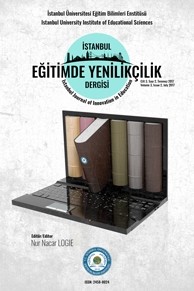Assessing E-learning Readiness of Instructors in Turkey
Assessing E-learning Readiness of Instructors in Turkey
E-learning e-learning readiness, e-readiness, instructors, learning style,
___
- Agboola, A. K. (2006). Assessing the awareness and perceptions of academic staff in using e-learning tools for instructional delivery in a post-secondary institution: A case study. The Innovation Journal: The Public Sector Innovation Journal, 11(3), 2–12.
- Akaslan, D., & Law, E. L. (2011). Measuring teachers’ readiness for e-learning in higher education institutions associated with the subject of electricity in Turkey. In 2011 IEEE Global Engineering Education Conference (EDUCON) (pp. 481–490). doi:10.1109/EDUCON.2011.5773180
- Aydın, C. H., & Tasci, D. (2005). Measuring readiness for e-Learning: Reflections from an emerging country. Journal of Educational Technology & Society, 8(4).
- Çobanoğlu, İ., Ateş, A., İliç, U., & Yılmaz, E. (2009). Investigating prospective computer teachers’ perceptions on e-learning. Procedia - Social and Behavioral Sciences, 1(1), 1460–1463. doi:10.1016/j.sbspro.2009.01.257
- Docebo. (2014). E-Learning Market Trends & Forecast 2014 - 2016 Report. Retrieved from http://www.docebo.com/landing/contactform/elearning-market-trends-andforecast-2014-2016-docebo-report.pdf
- Haney, D. (2002). Assessing organizational readiness for E-learning: 70 questions to ask. Performance Improvement, 41(4), 10–15.
- Keramati, A., Afshari-Mofrad, M., & Kamrani, A. (2011). The role of readiness factors in E-learning outcomes: An empirical study. Computers & Education, 57(3), 1919–1929. doi:10.1016/j.compedu.2011.04.005
- Lopes, C. T. (2007). Evaluating e-learning readiness in a health sciences higher education institution. In Proceedings of IADIS International Conference of E-learning, Porto.
- Sadik, A. (2007). The readiness of faculty members to develop and implement e-learning: The case of an Egyptian university. International Journal on E-Learning, 6(3), 433–453.
- Saekow, A., & Samson, D. (2011). A study of e-learning readiness of Thailand’s higher education comparing to the United States of America (USA)’s case. In 2011 3rd International Conference on Computer Research and Development (ICCRD) (Vol. 2,pp. 287–291). doi:10.1109/ICCRD.2011.5764134 So, K. K. T., & Swatman, P. M. C. (2006). e-Learning readiness in the classroom: A study of Hong Kong primary and secondary teachers. CollECTeR Europe 2006, 223–237.
- Soydal, I., Alır, G., & Ünal, Y. (2011). Are Turkish universities ready for e-learning: A case of Hacettepe University Faculty of Letters. Information Services and Use, 31(3),281–291.
- Unit, E. I. (2009). E-readiness rankings 2009: The usage imperative. The Economist. A Report from the Economist Intelligence Unit Written in Cooperation with the IBM Institute for Business Value. Retrieved from http://graphics.eiu.com/pdf/Ereadiness% 20rankings.pdf Wan, Z., Wang, Y., & Haggerty, N. (2008). Why people benefit from e-learning differently: The effects of psychological processes on e-learning outcomes. Information & Management, 45(8), 513–521. doi:10.1016/j.im.2008.08.003
- Watkins, R., Leigh, D., & Triner, D. (2004). Assessing readiness for e-learning. Performance Improvement Quarterly, 17(4), 66–79.
- ISSN: 2458-8024
- Başlangıç: 2015
- Yayıncı: İstanbul Üniversitesi
Assessing E-learning Readiness of Instructors in Turkey
Sushil.K SHARMA, Sevinç GÜLSEÇEN, Zeki ÖZEN, Elif KARTAL
Zeliha Özsoy GÜNEŞ, Fatma Gülay KIRBAŞLAR
Enhanced IMS Metadata for Surgical Education Simulators
Nergiz Ercil ÇAĞILTAY, İbrahim CERECİ
ISO 9126 Değerlendirme Modeli’nin Adapt Framework’e Uygulanması
Alaskar ÖZPERÇİN, Nazlı CİHAN, Nur NACAR-LOGİE, Vakur ÇİFTÇİLİ
Parental conflict and its association with sibling relationships
Esra İşmen GAZİOĞLU, Ayşegül Kılıçaslan ÇELİKKOL
Araştırma ve Öğretimde Paralel Derlem Kullanımı: Uppsala Üniversitesi Örneği
Eğitsel Devinim Araştırmalarında Devinimsel Alan Kavramının Gözden Geçirilmesi
Burak KİRAS, Behiye BEZİR AKÇAY
Akademik Başarı ile Okul İklimi Arasındaki İlişki
